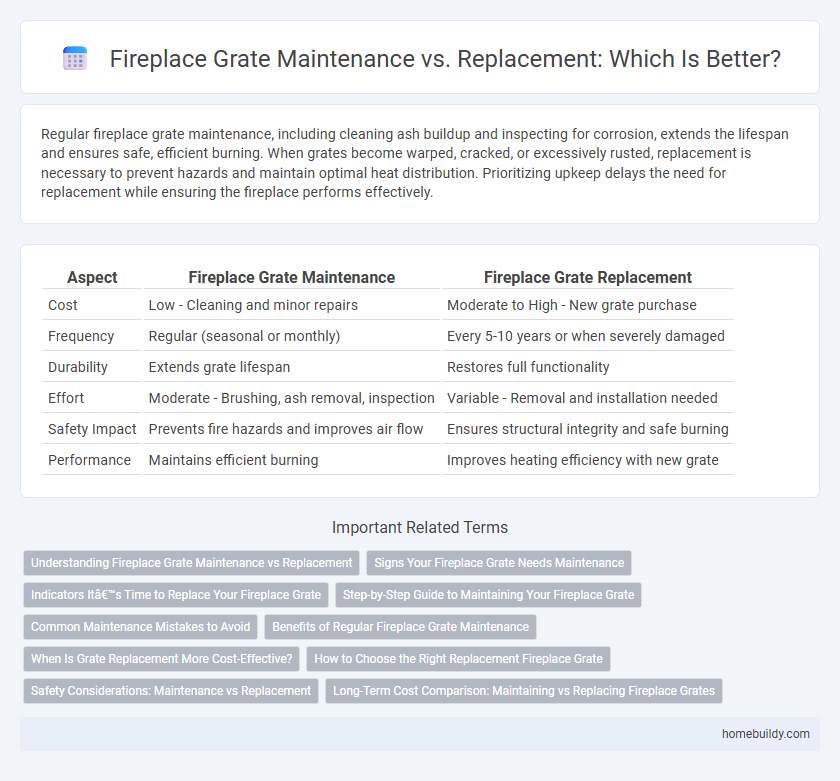Regular fireplace grate maintenance, including cleaning ash buildup and inspecting for corrosion, extends the lifespan and ensures safe, efficient burning. When grates become warped, cracked, or excessively rusted, replacement is necessary to prevent hazards and maintain optimal heat distribution. Prioritizing upkeep delays the need for replacement while ensuring the fireplace performs effectively.
Table of Comparison
| Aspect | Fireplace Grate Maintenance | Fireplace Grate Replacement |
|---|---|---|
| Cost | Low - Cleaning and minor repairs | Moderate to High - New grate purchase |
| Frequency | Regular (seasonal or monthly) | Every 5-10 years or when severely damaged |
| Durability | Extends grate lifespan | Restores full functionality |
| Effort | Moderate - Brushing, ash removal, inspection | Variable - Removal and installation needed |
| Safety Impact | Prevents fire hazards and improves air flow | Ensures structural integrity and safe burning |
| Performance | Maintains efficient burning | Improves heating efficiency with new grate |
Understanding Fireplace Grate Maintenance vs Replacement
Regular fireplace grate maintenance, including cleaning ash and inspecting for warping or cracks, extends its lifespan and ensures safety. Over time, metal fatigue and severe damage may necessitate replacement to prevent hazards and maintain efficient combustion. Knowing when maintenance no longer suffices helps homeowners avoid costly repairs and fire risks.
Signs Your Fireplace Grate Needs Maintenance
Signs your fireplace grate needs maintenance include visible rust, warping, or sagging that compromise its structural integrity and efficiency. Accumulated ash and debris that restrict airflow indicate the grate requires thorough cleaning to maintain proper combustion. Cracks or broken bars signal that replacement may soon be necessary to prevent safety hazards and ensure optimal fireplace performance.
Indicators It’s Time to Replace Your Fireplace Grate
Visible warping, rust accumulation, and persistent structural damage are clear indicators it's time to replace your fireplace grate, as maintenance can no longer ensure safe and efficient performance. Frequent difficulty in loading wood or uneven burning patterns often signal compromised grate integrity requiring replacement. Regular inspection for cracks, excessive ash buildup, and twisted metal helps determine whether cleaning and minor repairs suffice or a new grate installation is necessary.
Step-by-Step Guide to Maintaining Your Fireplace Grate
Maintaining your fireplace grate involves regular cleaning to remove ash and debris, preventing rust by applying heat-resistant paint, and inspecting for any signs of wear or warping. Use a wire brush to scrub off residue and ensure proper airflow, which enhances combustion efficiency and prolongs the grate's lifespan. Replace the grate if you notice significant structural damage or persistent corrosion that compromises safety and performance.
Common Maintenance Mistakes to Avoid
Regular cleaning of a fireplace grate is essential to prevent ash buildup that can obstruct airflow, but avoiding harsh wire brushes helps preserve its metal integrity. Neglecting to check for warping or cracks can lead to structural failure, making timely inspections crucial for safety and efficiency. Using the grate beyond its heat tolerance without proper maintenance accelerates wear, indicating when replacement is necessary to maintain optimal fireplace performance.
Benefits of Regular Fireplace Grate Maintenance
Regular fireplace grate maintenance enhances heat efficiency and prolongs the lifespan of the grate by preventing rust and structural damage. It reduces the buildup of ashes and debris, ensuring better airflow and safer combustion. Timely maintenance lowers the risk of costly replacements and keeps the fireplace functioning optimally year after year.
When Is Grate Replacement More Cost-Effective?
Fireplace grate replacement becomes more cost-effective when visible signs of warping, cracking, or significant rust compromise its structural integrity, reducing safety and heating efficiency. Continuous repair costs and frequent maintenance due to deteriorating metal can exceed the price of a new, durable grate made from high-quality cast iron or steel alloys designed for long-term use. Investing in replacement ensures optimal airflow, proper wood combustion, and prevents costly damage to the fireplace interior caused by improper grate function.
How to Choose the Right Replacement Fireplace Grate
Selecting the right replacement fireplace grate involves assessing the material, size, and design to ensure optimal durability and compatibility with your fireplace. Cast iron grates offer superior heat retention and longevity, while steel grates provide lightweight strength and affordability. Accurate measurements and consideration of your fuel type, such as wood or coal, are essential for maximizing airflow and efficient combustion in your replacement grate.
Safety Considerations: Maintenance vs Replacement
Regular fireplace grate maintenance involves inspecting for cracks, removing ash buildup, and ensuring proper airflow to prevent overheating and structural weakness, significantly reducing fire hazards. Replacement becomes essential when metal fatigue or warping compromises the grate's stability, posing risks of collapsed logs or sparks escaping into the living area. Prioritizing safety, timely replacement mitigates potential fire outbreaks and protects both property and occupants from unexpected grate failure.
Long-Term Cost Comparison: Maintaining vs Replacing Fireplace Grates
Regular maintenance of fireplace grates, including cleaning and rust prevention, extends their lifespan and minimizes the need for costly replacements. While initial maintenance expenses are lower, failing to maintain grates can lead to structural damage requiring expensive replacement units. Over time, investing in routine upkeep proves more cost-effective than frequent replacements driven by neglect and wear.
Fireplace grate maintenance vs Fireplace grate replacement Infographic

 homebuildy.com
homebuildy.com